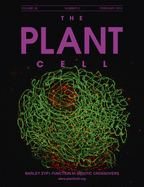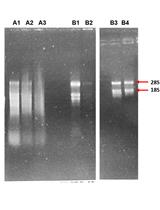- EN - English
- CN - 中文
Polysomal-mRNA Extraction from Arabidopsis by Sucrose-gradient Separation
采用甘蔗梯度分离法提取拟南芥多聚核糖体-mRNA
发布: 2014年12月20日第4卷第24期 DOI: 10.21769/BioProtoc.1364 浏览次数: 13061
评审: Tie LiuAnonymous reviewer(s)
Abstract
mRNAs surrounded by polysomes are ready for translation into proteins (Warner et al., 1963); these mRNAs are defined as polysomal-mRNAs (Mustroph et al., 2009). The process is affected by various growth conditions or surrounding situations. Microarray analysis is a powerful tool for detecting genome-wide gene expression. Therefore, using polysomal-mRNAs for microarray analysis can reflect the gene translation information (the translatome) under different developmental stages or environmental conditions from eukaryotes. Polysomal-mRNAs can be collected from the polysomal fraction by sucrose-gradient separation for further quantitative PCR or microarray assay. We modified a protocol (Mustroph et al., 2009) for collecting polysomal-mRNAs via sucrose-gradient separation to eliminate monosomal-mRNA contamination from pLAT52:HF:RPL18 Arabidopsis. This transgenic Arabidopsis uses a pollen-specific promoter (ProLAT52) to generate epitope-tagged polysomal-RNA complexes that could be purified with a specific antigen (Lin et al., 2014). The polysomal-mRNAs we obtained via sucrose-gradient separation and antibody purification underwent in vivo translation in pollen tubes grown from self-pollinated gynoecia of Arabidopsis thaliana.
Keywords: Polysomal-mRNA (多聚核糖体的mRNA)Materials and Reagents
- pLAT52: HF-RPL18 transgenic Arabidopsis
- RNase-free water
- Tris buffer (Sigma-Aldrich, catalog number: T1378 )
- KCl (Sigma-Aldrich, catalog number: P9541 )
- EGTA (Sigma-Aldrich, catalog number: E3889 )
- MgCl2 (Sigma-Aldrich, catalog number: M8266 )
- β-mercaptoethanol (Sigma-Aldrich, catalog number: M6250 )
- Cycloheximide (Sigma-Aldrich, catalog number: C7698 )
- Chloramphenicol (Sigma-Aldrich, catalog number: C0378 )
- Polyoxyethylene 10 tridecyl ether (PTE) (Sigma-Aldrich, catalog number: P2393 )
- Sodium deoxycholate (DOC) (Sigma-Aldrich, catalog number: D6750 )
- Dithiothreitol (DTT) (Sigma-Aldrich, catalog number: D0632 )
- Phenylmethylsulfonyl fluoride (PMSF) (Sigma-Aldrich, catalog number: P7626 )
- Triton X-100 (Sigma-Aldrich, catalog number: X-100 )
- Polyoxyethylene(23)lauryl ether (Brij -35) (Sigma-Aldrich, catalog number: P6938 )
- Tween-20 (Sigma-Aldrich, catalog number: P1379 )
- NP-40 (Sigma-Aldrich, catalog number: NP 40 )
- Polyoxyethylene (Sigma-Aldrich, catalog number: P2393)
- Deoxycholic acid (Sigma-Aldrich, catalog number: D2510 )
- ANTI-FLAG® M2 Affinity Gel (Sigma-Aldrich, catalog number: A2220 )
- RNAsin (Promega Corporation, catalog number: N2511 )
- 3x FLAG peptide (Sigma-Aldrich, catalog number: F4799 )
- Sucrose (Sigma-Aldrich, catalog number: 84097 )
- Polysomal extraction buffer preparation (see Recipes)
- 20% detergent mixture (see Recipes)
- 20% PTE and 10% DOC (see Recipes)
- Sucrose gradient layer preparation (see Recipes)
- 10x sucrose salts (see Recipes)
- Preparation of the FLAG M2 Agarose beads (see Recipes)
Equipment
- QIAGEN QIA shedder columns (QIAGEN, catalog number: 27115 )
- 15-ml tube (Labcon, catalog number: 9205-946CB-946C )
- Hitachi ultracentrifuge himac CP100WX (Hitachi, catalog number: CP100WX )
- Hitachi P40ST swing rotor (Hitachi, model: P40ST )
- 13PA tubes (Hitachi, catalog number: 332901A )
- Spectrophotometer (Beckman Coulter, catalog number: DU648B )
- UV monitor (GE Healthcare, catalog number: UVIS-920 )
- Pump (GE Healthcare, model: P-50 )
- Fraction collector (Gilson Products, catalog number: FC80 )
- UV detector system (GE Healthcare, catalog number: monitor UVIS-0912 )
- Recorder (GE Healthcare, catalog number: pharmaria LKB REC102 )
Procedure
文章信息
版权信息
© 2014 The Authors; exclusive licensee Bio-protocol LLC.
如何引用
Lin, S. and Jauh, G. (2014). Polysomal-mRNA Extraction from Arabidopsis by Sucrose-gradient Separation . Bio-protocol 4(24): e1364. DOI: 10.21769/BioProtoc.1364.
分类
植物科学 > 植物分子生物学 > RNA > RNA 提取
分子生物学 > RNA > RNA 提取
生物化学 > RNA > mRNA翻译
您对这篇实验方法有问题吗?
在此处发布您的问题,我们将邀请本文作者来回答。同时,我们会将您的问题发布到Bio-protocol Exchange,以便寻求社区成员的帮助。
Share
Bluesky
X
Copy link













